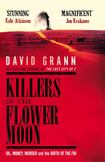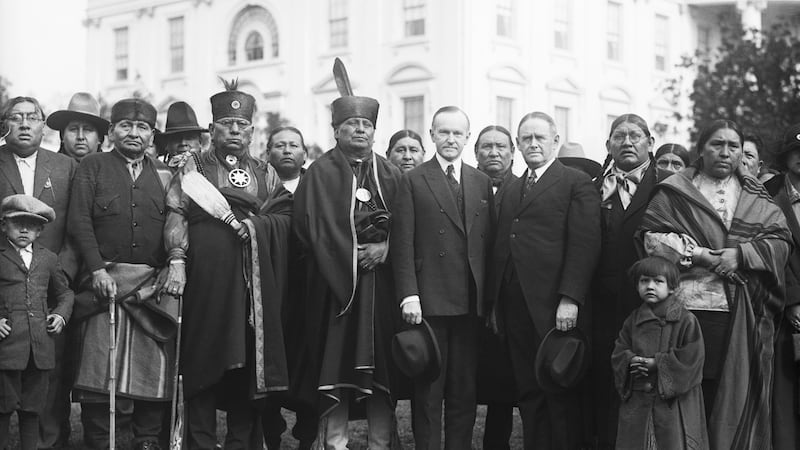
Genocide casts strange shadows, none darker than the story of the Osage people of Kansas. Driven from their lands in the early 1870s, they were abandoned in the barrens of Oklahoma. Their acuity added to their downfall: they had mineral rights written into their treaty with the United States. They held the land, and they also held the vast, soon-to-be-discovered reservoir of oil beneath it. The calamity of the Osage oil is the subject of Killers of the Flower Moon, by the New Yorker writer David Grann.
The Osage were canny as far as it went, but oil is the devil’s bounty. In the previous few decades the Osage way of life had been laid waste. Forced assimilation, alcoholism and sexual exploitation were the backwash of colonialism. They were resilient, given their circumstances, but resilience can carry you only so far.
Gregory Corso said that money doesn’t come with instructions. The Osage were awash with it. They built big houses and bought fancy cars, employed white servants. The one thing they couldn’t buy was protection from the chancers and charlatans drawn to their wealth. Nor could they defend themselves against state lobbyists for change to their legal status, eventually granted.

Osage were now obliged in most cases to have white guardians appointed to them, with control over their legal and financial affairs supplanting the cruder method of gaining control of the money: marrying an Osage woman.
In May 1921 the first death occurred. The rotting corpse of Anna Brown, a 34-year-old Osage woman, was found outside the town of Gray Horse, Oklahoma. She had been shot. She was the first of many. A winnowing was to take place among the “red millionaires”. Dozens were to die in the years that followed, poisoned, shot, their houses bombed.
You’d wonder if the case would have got anywhere had J Edgar Hoover not made it a test for his newly formed FBI. At the start the investigation met dead ends. Information leaked. Local law enforcement was not to be trusted. Pinkerton types were sent from the east, only to be seen consorting with bootleggers and outlaws. A web of complicity and silence engulfed the prairie towns. Not only the Osage died. One attorney, WW Vaughn, was stripped naked and thrown from a train to his death. Investigators trod carefully and locked their doors at night.
Hoover sent a former Texas Ranger named Tom White. White was dogged, high minded, an investigator of the old school and a dead shot. An individualist whose values were the opposite of the science-based detection that Hoover wanted to establish.
There is something improbable about White. Too much of the man of honour, requisitioned from the morality tales of the old west. A figure of justice placed among the scoundrels to redeem the whole enterprise. You have to trust Grann in this. If there was a crack in White’s righteous facade, you have to believe, the writer would have found it.
White knew his villains, and he set about them with determination. The bootlegger Kelsie Morrison. The rodeo star and bank robber Henry Grammer. The Shoun brothers, ghastly doctors to the Osage, always ready with a needle, aficionados of the lingering death. And, worst of all, the devious and amoral cattleman William K Hale, self-styled friend of the Osage and king of the Osage Hills.
The press were enthralled by the Osage, their cars and houses, their girls dressed in "sumptuous French clothing, as if une très jolie demoiselle of the Paris boulevards had inadvertently strayed" into the little prairie towns. You feel that Hoover might have wanted some of that attention. And part of you wonders if Hoover craved the darkness that had descended on the prairie, the ravening beast that had strayed into Gray Horse, Pawhuska and Fairfax, part of him appreciating the calculation involved in the murders. How the dead were shepherded in their dying, directed towards the opportunity of maximum profit. The legal requirements about who must die first, who must die at the same time. The Osage caught in their insistence that the crucial headrights, the share that each would get from the mineral rights, could be passed only by inheritance.
And you’d have to suspect that once Hoover got what he wanted from it he had little interest in the deeper implications of events, or the lost worlds of first Americans.
Grann writes well, his material well organised, the weight of research borne lightly. But there are undercurrents. His approach is empirical, European. Facts established, events exhaustively researched. There are 30 dense pages of archive, notes and sources at the end of the book. But this is a story of new America. The Osage are bystanders, and that is troubling. Empirical thinking redefined and confiscated their world. In photographs reproduced in the book they face the camera with a sombre, violated gaze.
The title of the book derives from an Osage reference to the May moon that coincides with the withering of early prairie flowers. Osage culture refers to spiritual leaders in times of trouble as Travellers in the Mist. There’s a linguistic grace when it is rendered into English, but condescension is worked into it as well. Their language means what we think it to mean. We assume poetry where there may be only utility.
The victims remain peripheral to the relating of their downfall. Grann meets contemporary members of the tribe who are able to supply information. They are mournful, dignified, aware of how human agency works, how hard it is to get it back when it is gone. They come across as helpful but guarded, aware, you would think, of the small but acute pain of a 21st-century newspaperman putting words to a hurt that they knew only too well. They don’t need to be told what was done to them.
Grann constructs the book well but takes the shaping too far. Withholding revelation is hardly a new technique – it is part of a popular writer’s arsenal – but the work mustn’t seem bent out of shape. Grann does uncover new evidence, a widening of the killing circle. Many more deaths went unreported. But the technique is superficial beside the real meaning of his final discovery: how it demonstrates the rendering of entire peoples as subhuman the better to erase them from the earth.








